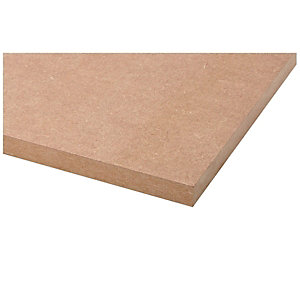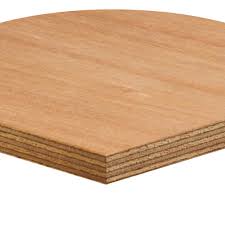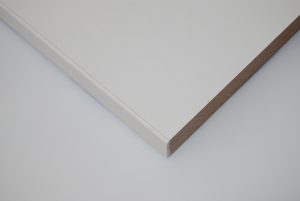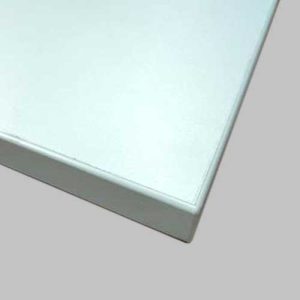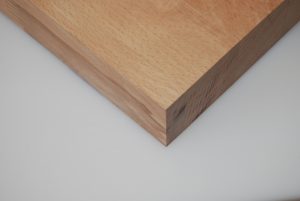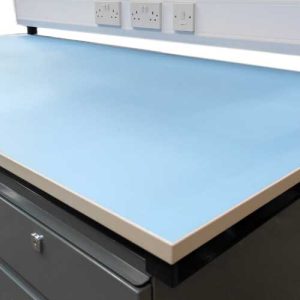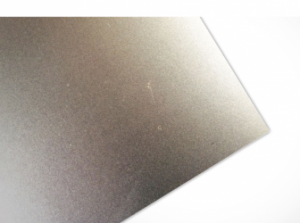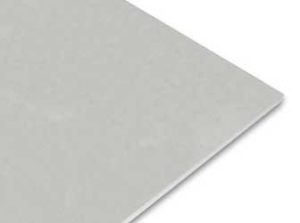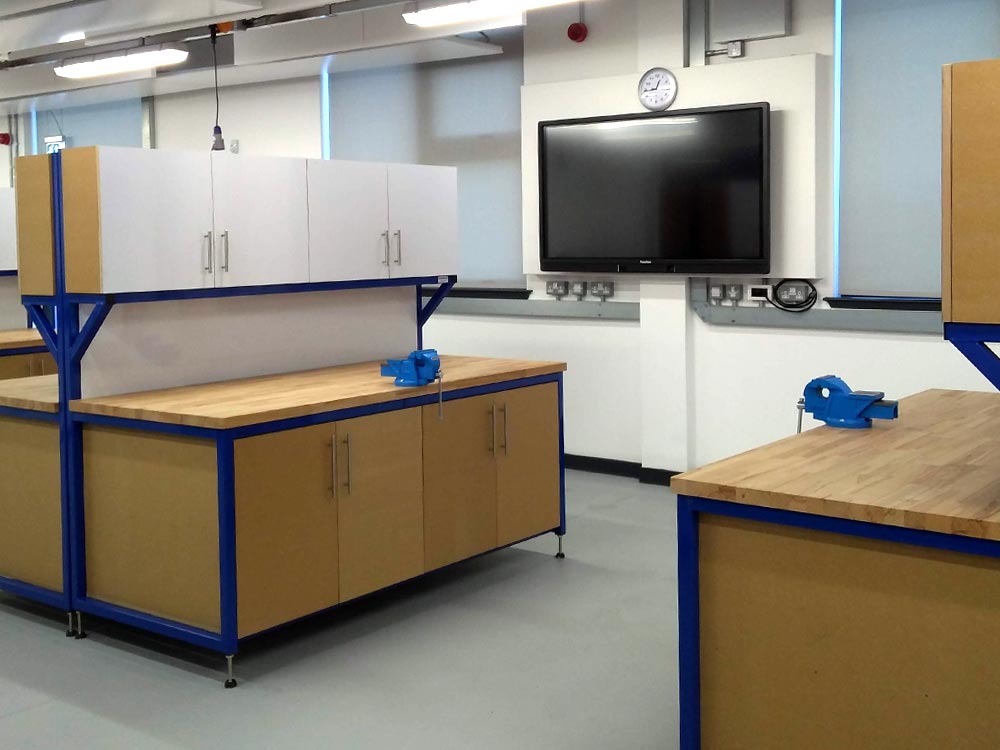
Read our guide below to find out about the most popular workbench worktop materials
First of all, we’ll go through some of the pros and cons of popular workbench worktop materials, including how to care for your worktops. In our next article, we’ll look at what workbench worktop material is the best fit in particular scenarios and to suit certain types of workbench.
Worktop Material -- MDF
What is MDF?
MDF stands for "medium density fibreboard". It is an engineered wood product made from wood fibres that have been pressed into shape along with glue and resin
Is MDF eco-friendly?
Whilst MDF is often considered to be a less eco-friendly material, the fact it can be produced using recycled wood fibres means it can be a more affordable and sustainable alternative to solid wood. As it is a composite material, however, the manufacturing process produces emissions and waste, which can have an environmental impact. MDF is also not fully biodegradable due to the resins and glues used in production.
Is MDF a good workbench worktop material?
MDF is an inexpensive and versatile material that can be used for a wide range of furniture building applications as well as for use as workbench worktops. MDF is easy to shape and can be cut, drilled and sanded with ease, it also has a uniform density and texture meaning it's a good surface for laminating and veneering.
Compared to solid woods, MDF is not as durable or resistant to heat or moisture. If left wet then MDF can swell and crumble, so it's best used in dry environments unless it has been coated with some form of protection.
Overall, MDF can be a good option for a workbench worktop as it's relatively inexpensive, versatile and easy to shape and form, but it's not as durable or moisture/heat resistant as other materials.
How to clean an MDF Worktop
Cleaning an MDF worktop is relatively straightforward, but it's important to use the appropriate cleaning methods and products to avoid damaging the surface. Here are some general steps to follow when cleaning an MDF worktop:
- Clear the surface of dust and debris
- Use a soft slightly damp cloth or sponge to wipe down the surface, avoid using abrasive materials such as steel wool or scouring pads as they can scratch the surface.
- Wipe the worktop dry
- Let the surface dry thoroughly before placing anything back on the work surface
We manufacture many types of workbench with MDF tops including general-purpose industrial workbenches, as well as packing benches, and mobile workbenches.
Worktop Material -- Plywood
What is Plywood?
Plywood is an engineered wood product which is made by gluing many layers of thin wood together.
Is Plywood eco-friendly?
Plywood can be a much more environmentally friendly and sustainable worktop option than solid wood. This is due to the way in which the plywood is manufactured, using thin layers of wood allows for efficient use of wood resources. Plywood is most often made from fast-growing and renewable tree species such as pine and poplar. Some manufacturers use sustainable practices like using eco-friendly adhesive and certifying their plywood with FSC (Forest Stewardship Council) which ensures that the wood used is from responsibly managed forests.
One consideration however is that plywood is a composite product made from wood fibers and resin binders, which are often derived from petrochemical sources, and the production process of it generates emissions and produces waste, which can have an environmental impact.
It is important to note that the environmental impact of plywood can vary depending on the sourcing, production and disposal methods used by manufacturers.
Is Plywood a good workbench worktop material?
Plywood is an engineered wood product that is made by glueing together thin layers of wood veneers. The grains of these layers run at right angles to the previous layer. As such, plywood is very strong and durable, making it a good option for workbench worktops.
However, plywood is not as durable as some other worktops such as standard hardwoods, and plywood can also be damaged by heat or chemicals. Sometimes some of the wood layers can also chip over time, especially on edges that do not have some form of edge banding or protection.
Overall, plywood can be a good option for a workbench worktop as it's It is also relatively inexpensive, easy to cut and shape, and can be sanded and painted or varnished to make it more durable or aesthetically pleasing.
How to clean a Plywood Worktop
- Make sure the surface is free of dust and debris by wiping with a dry cloth, microfibre cloth, or soft-bristled brush
- Then wipe the worksurface down with a damp cloth. Avoid using excessive amounts of water as this can cause warping or swelling.
- If there are stains you could try a mild detergent but this may discolour the worktop so do a spot test first in a hidden area if possible
- Always avoid using abrasive or harsh cleaning chemicals, as these can damage the surface of the plywood.
- Ensure the surface is fully dry before placing items on the workbench surface
We manufacture several types of workbenches with plywood tops, including heavy-duty workbenches and cutting tables.
Worktop Material -- Laminate Board
What is Laminate?
Laminate is a composite material made by layering paper impregnated with resin and then bonding these layers together using heat and pressure.
The resulting laminate is then often bonded to wood-based boards and sheets such as chipboard or MDF to create a durable and decorative surface that is commonly required in furniture making.
Is Laminate eco-friendly?
Laminate boards can be considered as a relatively sustainable material as at their core they are made from wood-based materials. However, the production process of the laminate board is energy-intensive, and it is not a biodegradable material, which means it will not decompose in a natural environment.
Additionally, the production process can create waste and pollution. One of the main concerns here is that the adhesives and resins used in the manufacturing process can release formaldehyde and other volatile organic compounds. These can be harmful to the environment and human health.
Overall, laminate board can really only be considered an eco-friendly material when it's produced responsibly, with low levels of pollutants and waste, and created using sustainable sources like FSC-certified wood.
Is Laminate a good workbench worktop material?
Laminate is often used as a worktop material because it is relatively inexpensive, easy to clean and maintain, and comes in a variety of colors and patterns. Laminate work surfaces are durable and can withstand heavy use whilst resisting stains, scratches, and dents, making them ideal for use as worktops in demanding environments including shops, schools, warehouses, and factories.
Laminate worktops are also easy to clean, but can be damaged by certain chemicals and solvents.
Bear in mind that laminate is not as heat-resistant as some other materials, and can be damaged by excessive heat or direct sunlight. One consideration here is that laminate can sometimes peel away from its core board over time as the glues degrade with age or in extreme temperatures, and this can lead to the edges of the laminate or worktop being chipped or damaged.
How to clean a Laminate Worktop
- Remove any dust or debris from the worksurface using a dry soft cloth, a microfibre cloth, or a soft-bristled brush
- Wipe the surface down with a damp soft cloth
- To remove any stains, try rubbing with a mild detergent and a non-abrasive sponge but don't scrub too hard as you m scratch the laminate
- Take care not to catch the edges when wiping down as this could loosen the edgebanding (if applied)
- Ensure the work surface is fully dry before placing items back on the worktop
We manufacture a wide range of laminate-topped workbenches including electrical workstations and cantilever workbenches, as well as packing stations.
Worktop Material -- Melamine Board
What is Melamine?
Melamine is a type of laminate as above, but the difference is that melamine is considered to be a low-pressure laminate as it is manufactured using less pressure than a standard laminate.
Like the laminate board above, melamine board is a type of engineered wood product made from particleboard or MDF that is then coated with a thin layer of melamine resin. Melamine resin is applied as a decorative and protective finish to the surface of the board. This coating provides a hard, durable surface that is resistant to scratches, stains, and moisture.
Is Melamine eco-friendly?
In terms of sustainability and eco-friendliness, melamine board is not as environmentally friendly as some other types of engineered wood products. The production process is energy-intensive, and the use of synthetic resins and adhesives can create waste and pollution. Additionally, the melamine resin coating is not biodegradable, so it will not decompose in a natural environment.
However, melamine board is made from wood-based materials which are a renewable resource and can be sourced from sustainably managed forests. The use of melamine board over solid wood can also help to save trees and reduce deforestation.
Taking all this into account, melamine board can be considered a sustainable option when it's produced responsibly, with low levels of pollutants and waste and when it comes from sustainable sources like FSC-certified wood.
Is Melamine a good workbench worktop material?
Melamine is often used as a worktop material because it is relatively inexpensive, easy to clean and maintain, and comes in a variety of colours and patterns. Melamine is also a durable material that can withstand heavy use and resist scratches, dents, and stains.
However, melamine is not as durable as some other worktop materials, such as solid surface materials or hardwoods. It can also be damaged by heat and chemicals, and the edge banding (the trim around the edge of the worktop) can peel or chip over time.
How to clean a Melamine Worktop
- Remove any dust or debris from the worksurface using a dry soft cloth, a microfibre cloth, or a soft-bristled brush
- Wipe the surface down with a damp soft cloth
- To remove any stains, try rubbing with a mild detergent and a non-abrasive sponge but don't scrub too hard as you may scratch the melamine
- Take care not to catch the edges when wiping down as this could loosen the edgebanding (if applied)
- Ensure the work surface is fully dry before placing items back on the worktop
We can supply melamine worktops for many of our workbench designs, though they are commonly requested by the warehouse industry for warehouse equipment and computer workstations.
Worktop Material -- Block Beech
What is Block Beech?
Block beech is made by cutting beech logs into blocks and then slicing them into thin layers, which are then glued together to form a solid plank. The blocks are usually cut in a way that highlights the natural wood grain and colour variations of the beech wood.
Is Block Beech eco-friendly?
Block beech can be considered an environmentally friendly worktop option if the beech comes from a sustainably managed forest. Beech is a fast-growing tree species so it is a good option for sustainable forestry. As block beech flooring is durable, long-lasting and easy to repair and maintain, reducing the need for frequent replacement and minimizing the environmental impact of its use.
However, the production process of block beech flooring can be energy-intensive, and the use of adhesives and finishes can create waste and pollution. It is important to ensure that the product is sourced from responsibly managed forests and that the production process complies with sustainable practices.
Is Block Beech a good workbench worktop material?
Block beech is a type of hardwood that is commonly used for furniture and flooring, and it can also be a good material for a workbench worktop due to its strength and stability. It is also relatively dense and heavy, which can make it a good option for heavy-duty workbenches.
Block beech is also a good option for workbenches that will be exposed to heat and moisture, as it is a natural material that can withstand these conditions relatively well.
However, block beech is relatively expensive compared to some other worktop materials, and it can be prone to scratches and dents if not properly maintained.
How to clean Block Beech worktops
- Wipe the worksurface free of dust and debris using a soft or microfibre cloth
- Use a soft cloth or sponge to gently scrub the surface with a mild detergent
- Avoid using abrasive materials or harsh chemicals, as these can damage the wood
- Dry the surface with a soft cloth or microfiber to prevent water damage
- To maintain the natural color and finish of the beech, you can use a food-grade mineral oil or beeswax as a protective finish
We can supply block beech for all types of workbench including heavy-duty workbenches, industrial workstations, classroom tables, and workshop workbenches.
Worktop Material -- ESD Worktops
What is an ESD Worktop?
ESD stands for ElectroStatic Discharge, so an ESD worktop is a work surface that is designed to prevent the buildup of static electricity. This is important in certain environments such as electronic manufacturing or repair where sensitive electronic components are handled, as a static discharge can damage or destroy these components. It is important that they are grounded properly to ensure that they work as intended.
For our ESD worktops, we use a special ESD laminate or ESD rubber surface. These materials are chosen for their durability and resistance to chemicals and heat. They can be used as a standalone worktop or in combination with other ESD materials such as ESD mats or ESD wristbands.
Are ESD Worktops eco-friendly?
In terms of their eco-friendliness, it depends on the materials that were used to make the worktop and how they were produced. Some materials like epoxy resins are not biodegradable and produce emissions during their production process.
Additionally, ESD worktops can potentially be recycled or repurposed at the end of their lifespan, which can be beneficial for the environment.
Are ESD Worktops good for use as a workbench worktop material?
ESD worktops are a good workbench worktop material for electronic manufacturing or repair environments, where sensitivity to electrostatic discharge is crucial. They are durable, resistant to chemicals and easy to clean, which makes them suitable for heavy use. They help to prevent the build-up of static electricity, reducing the risk of damage to electronic components.
However, ESD worktops may not be the best choice for all types of workbenches, as they are relatively expensive compared to other materials, and they may not be suitable for certain types of work such as welding or woodworking.
How to clean an ESD Worktop
Cleaning an ESD worktop is similar to cleaning any other work surface, but it's important to use the appropriate cleaning methods and products to avoid damaging the surface or affecting its electrical properties.
It's important to keep in mind that an ESD worktop should always be properly grounded, so the cleaning process should not interfere with the grounding system.
- Wipe the surface with a soft cloth or soft-bristled brush to remove any dust or debris
- Using a soft damp cloth, wipe down the surface gently, and avoid using abrasives that can scratch the surface
- Ensure the surface is fully dry before placing items back on the worktop
We manufacture many styles of ESD workbench for our clients in the electronics sector, and we also supply them with additional ESD equipment including chairs, straps, matting, and cables to keep their workbenches safe.
Worktop Material -- Mild Steel
What is Mild Steel?
Mild steel is a type of low-carbon steel that is commonly used in a wide range of applications. It is a relatively inexpensive and versatile material that is easy to shape and form, and is used in the construction of buildings, vehicles, and household appliances, as well as in the production of various industrial products.
The properties of mild steel make it suitable for welding, cutting, drilling, and other forms of fabrication. It is also suitable for painting and galvanizing.
Is Mild Steel eco-friendly?
The production of mild steel generates emissions and produces waste, and also the mining of raw materials and the transportation of the final product add to its overall environmental footprint.
However, mild steel is a recyclable material, and steel recycling rates are high globally, which can be beneficial for the environment. The recycling process of steel is energy-efficient and generates fewer emissions compared to the production of new steel.
Mild steel can be produced from recycled steel scrap which helps conserve natural resources, reduces emissions and minimize the environmental impact.
Is Mild Steel a good workbench worktop material?
Mild steel can be a good material for a workbench worktop as it's relatively inexpensive and versatile for different types of work. However, mild steel is not as resistant to corrosion as stainless steel and it can rust if exposed to moisture or acidic environments.
How to clean a Mild Steel worktop
- Remove dust and debris using a soft cloth, microfibre cloth, or soft-bristled brush
- Wipe the surface with a slightly damp cloth
- If the mild steel worktop is stained with oil or grease, you can use a degreaser specifically formulated for steel surfaces.
- Avoid using steel wool or wire brushes as they can scratch the surface of the steel.
- Regularly check the surface for any signs of rust or corrosion and address them promptly.
We manufacture many types of heavy-duty workbenches with mild steel tops as well as engineering & welding workbenches.
Worktop Material -- Stainless Steel
What is Stainless Steel?
Stainless steel is a type of steel that contains at least 10.5% chromium, which gives it its characteristic corrosion resistance and shine. Stainless steel is commonly used in a wide range of applications including kitchen equipment, appliances, construction materials, and medical instruments.
Is Stainless Steel eco-friendly?
In terms of sustainability and eco-friendliness, stainless steel can be considered a relatively sustainable material. Stainless steel is durable and long-lasting, and can withstand harsh environments whilst also resisting corrosion.
Generally, stainless steel has a high recycling rate and can be recycled indefinitely. This helps to conserve natural resources and reduce waste. The production process of stainless steel however is energy-intensive and can create waste and pollution. There are many ways to reduce the environmental impact of stainless steel production though, such as recycling scrap steel, and using alternative energy sources to reduce emissions.
Stainless steel production does require the mining of raw materials such as iron ore and chromium, and this can have negative impacts on the environment. Stainless steel production also requires large amounts of energy, which can generate greenhouse gases if the energy sources used are not renewable.
Is Stainless Steel a good workbench worktop material?
Stainless steel is a durable and easy-to-clean material that is often used as a workbench worktop in industrial and laboratory settings. It is resistant to corrosion, staining, and heat damage, making it a good choice for environments where these factors are a concern. Additionally, it is a non-porous material, which means it is resistant to bacteria and other microorganisms. However, stainless steel can be expensive, and it may not be the most comfortable material to work on for long periods of time due to its hardness.
How to clean a Stainless Steel worktop
- Wipe down the worksurface with a soft or microfibre cloth
- Use mild detergent and warm water to gently scrub the surface to remove dirt & stains
- Avoid using steel wool or abrasive sponges as they can scratch the surface of stainless steel
- If being used in medical or food preparation environments ensure you use the correct cleaning and disinfecting solutions as required
- Wipe thoroughly with a clean damp cloth to remove detergent
- Dry the surface thoroughly to prevent water spots & streak marks
- Ensure the surface is dry before placing items back on the worktop
We manufacture stainless steel topped workbenches for use in health, medical, food preparation and veterinary applications.
Do you need help choosing your workbench worktop materials?
We manufacture all workbenches entirely to order, so we can supply you with the exact worktop to suit your needs.
Simply contact our helpful sales team to discuss your requirements.
Email: sales@spaceguard.co.uk
Phone: 01482 363445

